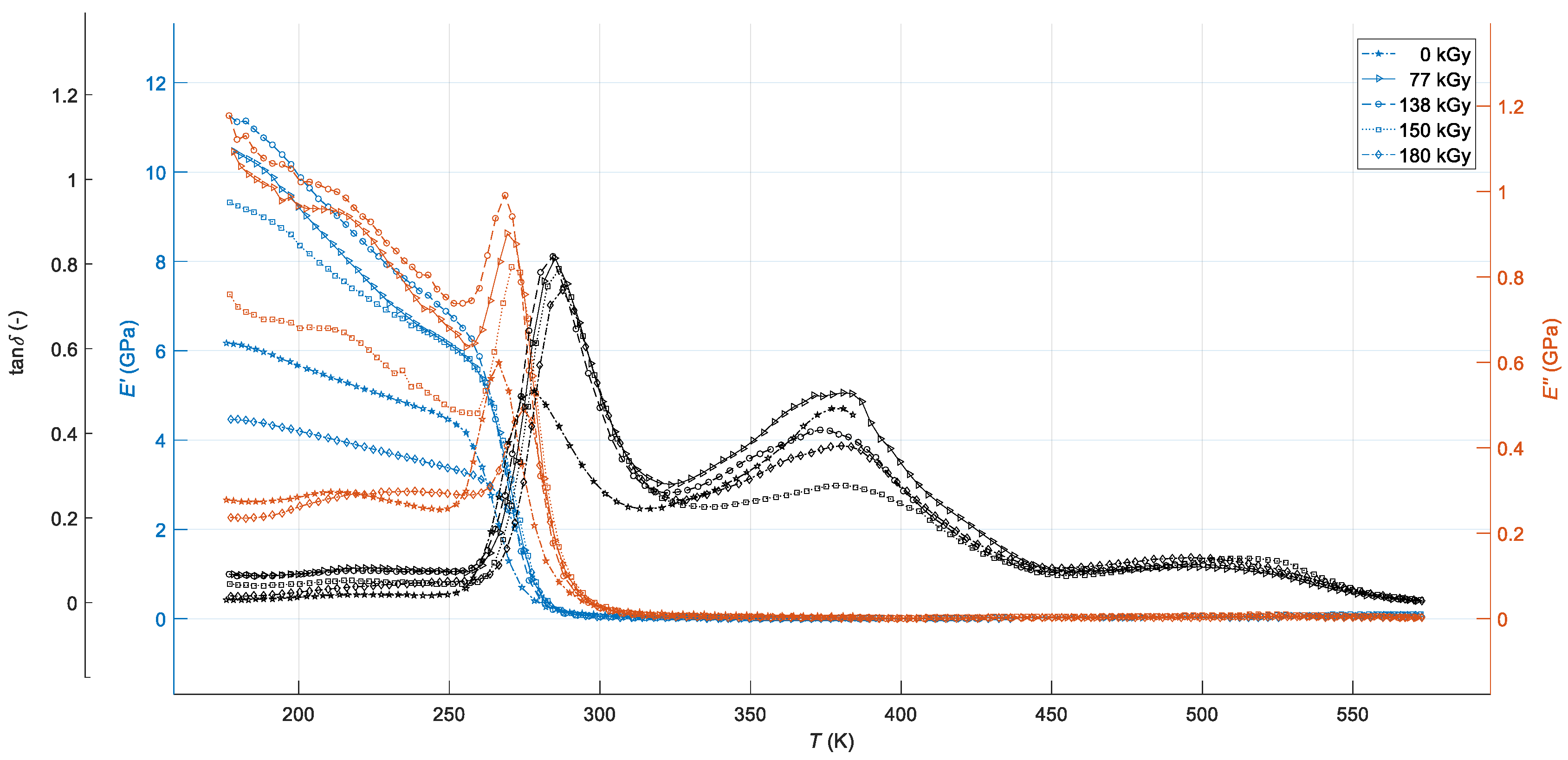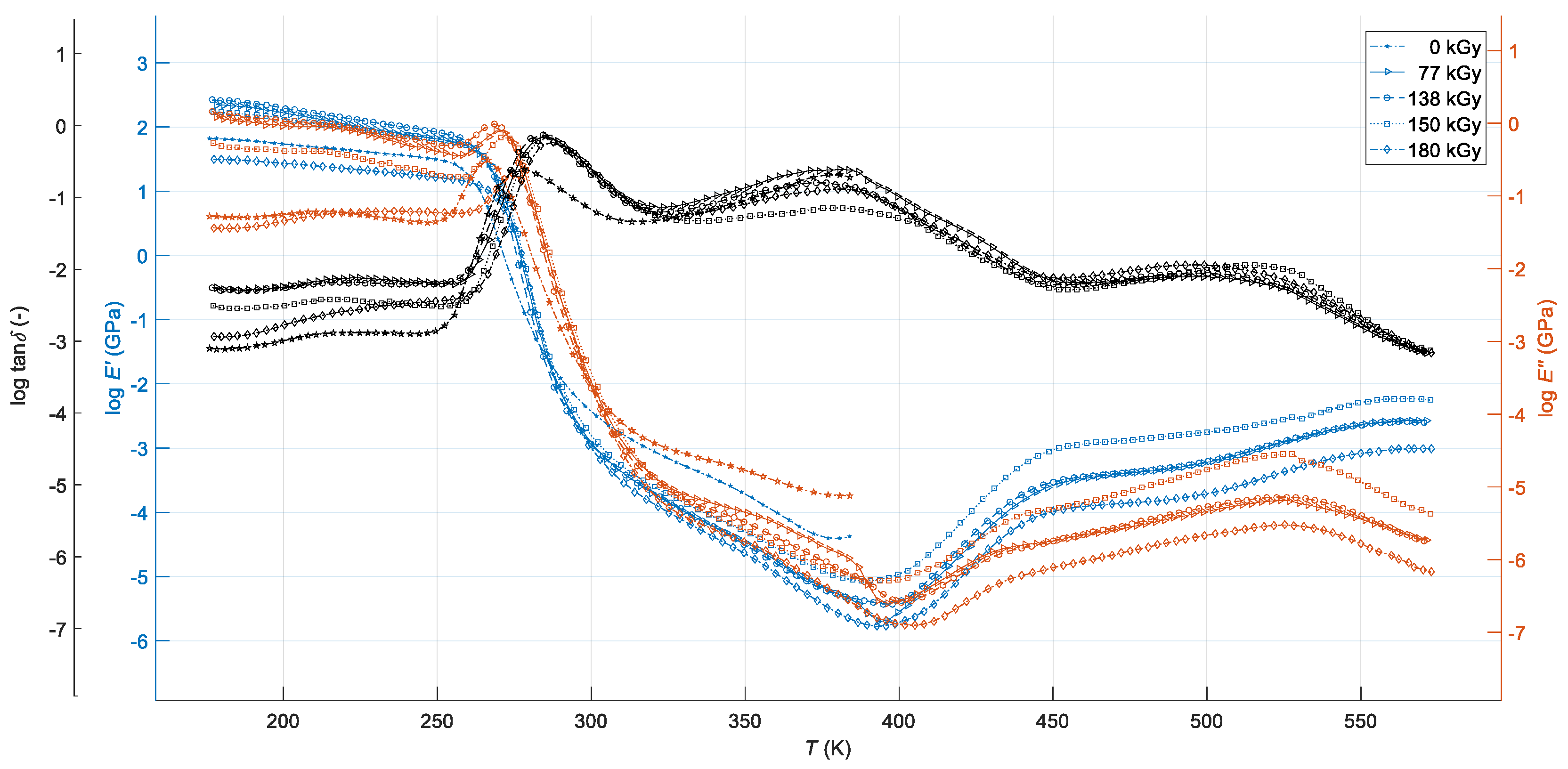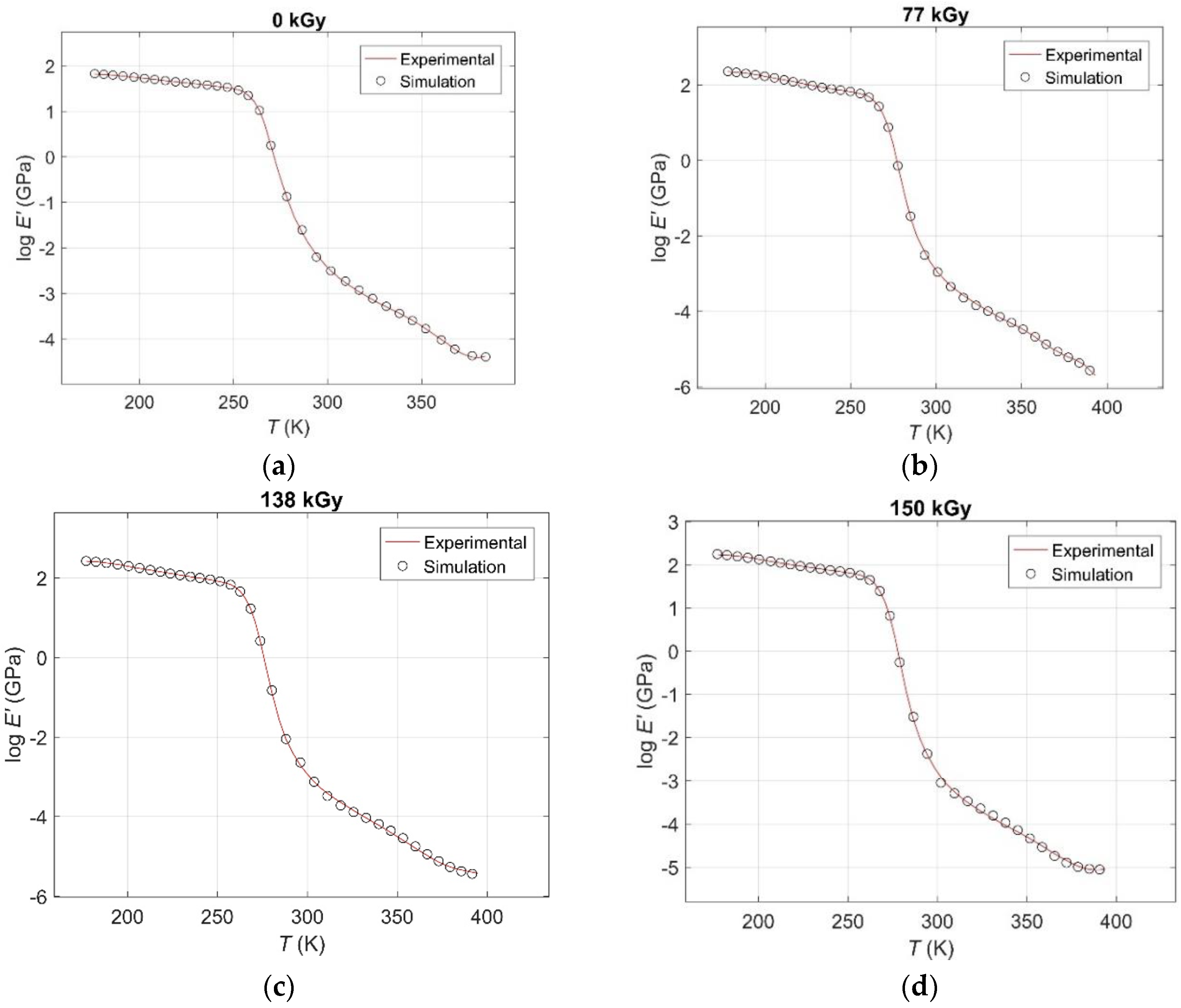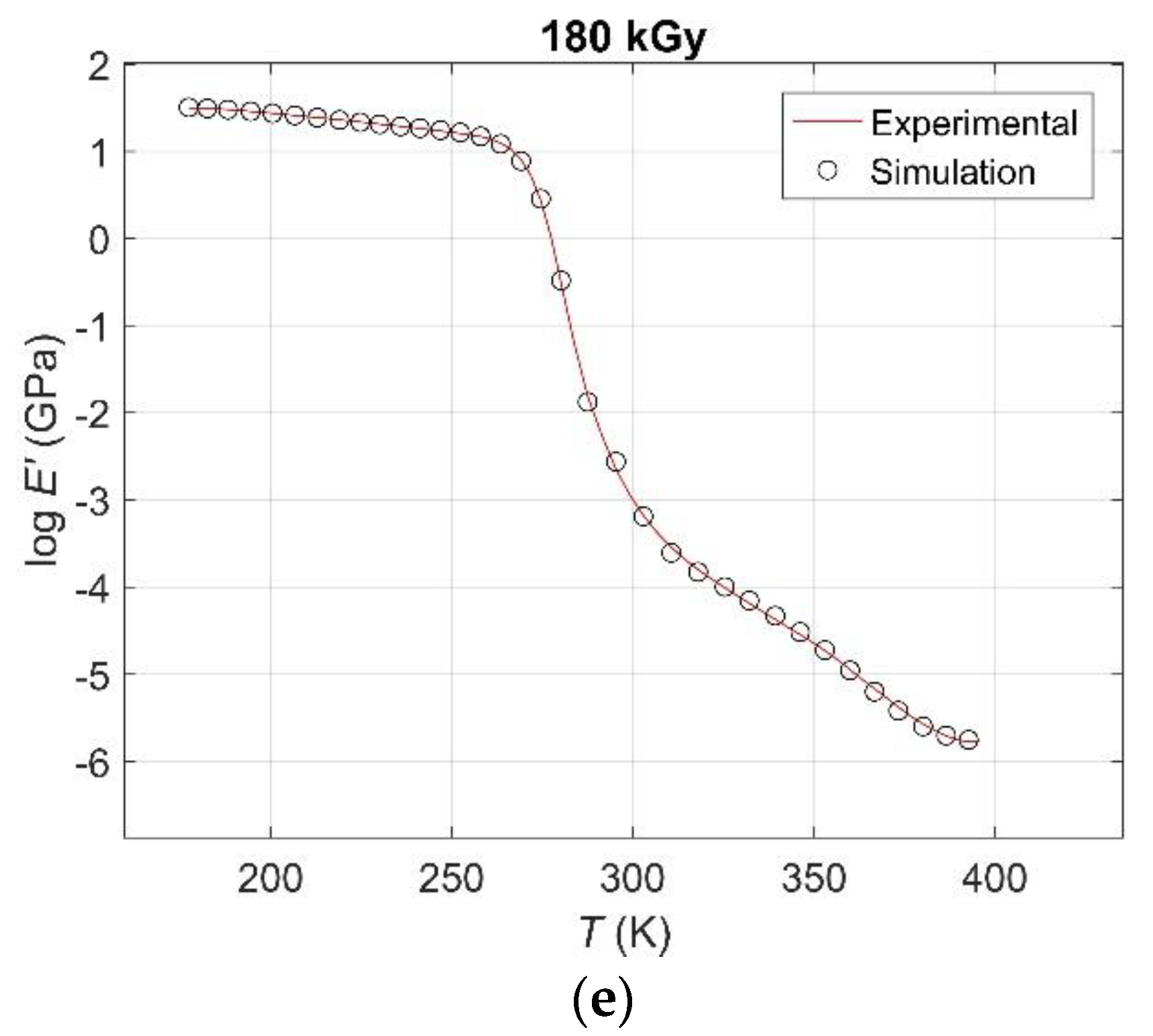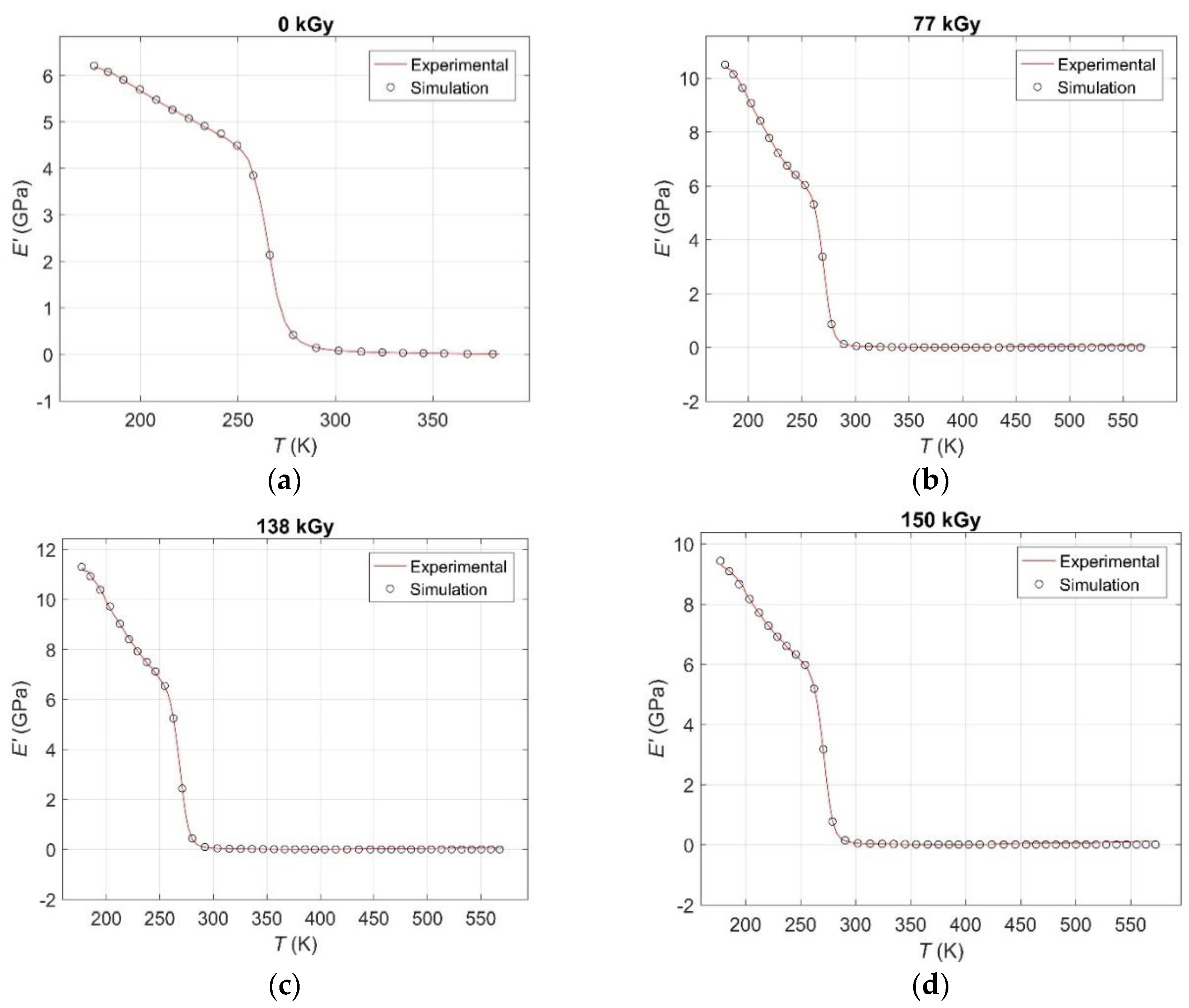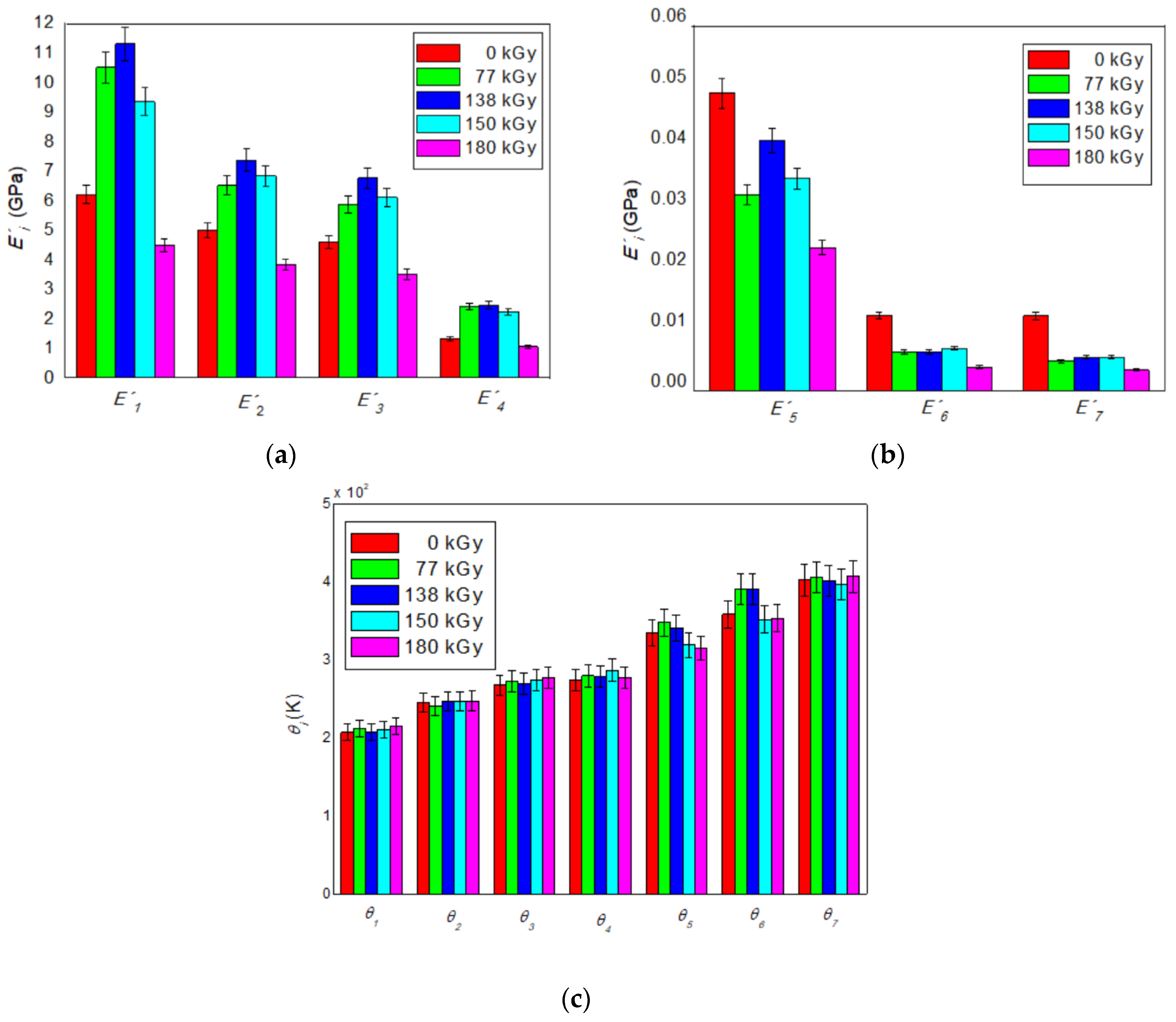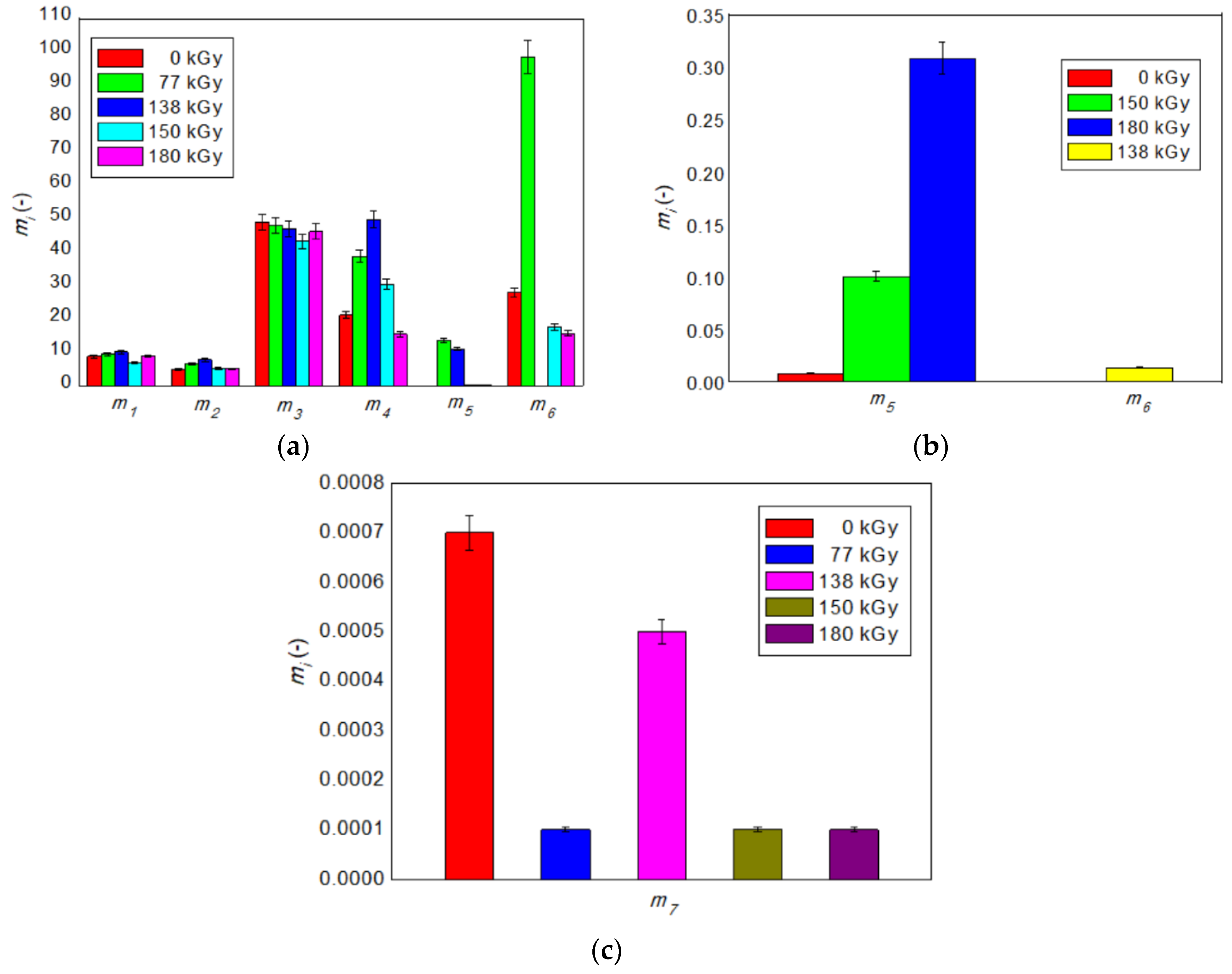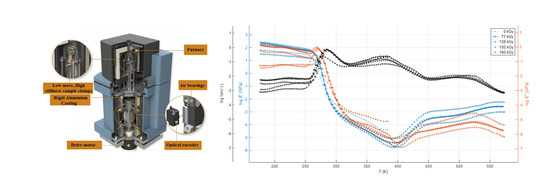3.1. Dynamic Mechanical Analysis
The dynamic mechanical response of virgin and high-energy EB-cured samples of the tested PMX3 resin-rubber blend for EB radiation doses of 77, 138, 150, and 180 kGy as a function of temperature in the range from 176 K to 573 K and a constant oscillating strain frequency of 1 Hz is shown in
Figure 1.
The DMA curves presented in
Figure 1 show features characteristic of amorphous, high-molecular-weight, lightly cross-linked, and multi-phase-separated thermosetting polymer systems [
26]. All three
E′(
T,d),
E″(
T,d) and tan
δ(
T,d) dependencies for temperature
T and each radiation dose
d show three distinct regions, namely: a glassy region at the temperature range from 176 K to about 275 K with high storage and loss moduli and very low values of loss tangent, where the large-scale segmental mobility of the polymeric chains is highly restricted, such that the tested material in bulk is in a glassy state, and it exhibits a hard, rigid and brittle mechanical behaviour; a glass transition region at temperatures from approximately 266 K to 299 K with a rapid drop in storage modulus by a factor up to 126 at temperature about 292 K toward its initial value and sharp peaks in loss modulus and loss tangent, where the long-range coordinated molecular motion of main chains starts; accordingly, the material occurs in the leathery state and its behaviour changes from the glass-like, hard, rigid and brittle to flexible, rubber-like soft and ductile; and a wide rubbery-plateau region at temperatures above roughly 286 K with a stable, small values of both moduli and non-monotonic changes in loss tangent, where the large-scale chain movements occur, such that the material is in the rubbery state, its stiffness stays very low, and it retains soft and ductile, rubber-like mechanical behaviour [
27]. The high level of ductility of the non-irradiated blend in the rubbery-plateau region, described in more detail in our previous work [
25], led to automatic interruption of the DMA test at a temperature of approximately 384 K. Moreover, on each of
E″(
T,
d) and tan
δ(
T,
d) curve, two broad shoulders in the glassy region, corresponding to the relatively weak inflexion points on the respective
E′(
T,d) curve, can be observed, whereas two broad peaks on tan
δ(
T,d) curves in the rubbery-plateau region occur, with the exemption of the non-irradiated sample with a single not-too-wide peak at the end of the curve. The temperature range of the individual transition regions, as well as the height and width of the individual relaxation peaks, obviously show a non-linear dependence on the size of the applied radiation dose, which is due to the different radiation sensitivity of the individual components of the investigated hybrid polymer mixture to the applied EB radiation [
6].
The presence of two independent clearly segregated relaxation peaks with different widths and degrees of irregularity in each loss tangent curve in the temperature range of about 250–450 K indicates an inhomogeneous, partially incompatible, and partly immiscible polymeric system with a three-phase-separated morphology [
28], which consists of a hard melamine resin phase, a hard phenol-formaldehyde resin phase, and a soft nitrile rubber phase. Generally, the broadening of the DMA damping peaks corresponding to the glass transition events is the indication of the compatibilisation of the multi-component polymeric systems associated with molecular mixing and chemical interactions of its individual components. At the same time, the presence of the two above-mentioned independent peaks with a significant interphase between them in this temperature range of the DMA test indicates that the level of the tested PMX3 blend compatibilisation did not markedly alter the level of its hard and soft phase components’ miscibility, whereas the width and shape of the second of the peaks indicate a relatively high degree of miscibility of both hard phases of the blend, which determines its resulting mechanical properties and behaviour at different temperature conditions [
29].
The relaxation peaks on all DMA curves in the glassy state at temperatures roughly between 176–253 K can be associated with the secondary γ-transition at temperature
Tγ, where localised bond movements (bending and stretching) and side-chain movements occur, and with the β-transition at temperature
Tβ due to vibrational and rotational motion of water as well as water-polymer blend complex molecules [
30], samples of which were not dried before the curing process. The α-transition peaks on
E″(
T,
d), as well as tan
δ(
T,d) curves in the leathery state of the blend at temperatures approximately from 266 K to 275 K and from 278 K to 288 K, respectively, correspond to the glass transition of nitrile rubber at temperature
Tg(NBR) [
31]. Mostly very indistinctly double, asymmetric damping peaks with faint interphase between them in the rubbery state of the blend at temperatures approximately between 317 K and 455 K can be associated with the glass transition of melamine resin at temperature
Tg(MFR) [
32] and phenol-formaldehyde resin at temperature
Tg(PF) [
33], respectively. However, these temperatures are, depending on the size of the radiation dose, shifted closer to each other compared to the glass transition temperatures of the individual resins of the blend due to the relatively high degree of miscibility of their molecules and the chemical interactions between their macromolecular segments affected by ionising radiation [
8]. At the same time, all three glass transition temperatures identified from the top of peaks on loss tangent curves are significantly shifted towards higher values compared to temperatures identified from peaks on loss modulus curves or from inflexion points on storage modulus curves. The asymmetrical shape of loss tangent peaks in the temperature range between 317 K and 455 K is the result of the inconsistent curing as well as non-stoichiometric blending, which led to the formation of an inhomogeneous polymer network with areas of various cross-link density [
34]. The presence of two broad shoulders on loss tangent curves in the rubbery-plateau region of the blend requires a more detailed analysis of functional dependencies
E′(
T,d) and
E″(
T,d) in its entire temperature range, which is allowed to display the registered DMA curves in the logarithmic scale shown in
Figure 2.
As one can be seen from
Figure 2, both the storage and loss moduli in the temperature range of approximately 286 K to 395 K and from 286 K to 405 K, respectively, continue to decrease with increasing temperature, except for the non-irradiated sample, whose DMA test was prematurely terminated at a temperature close to 384 K for the above reason. The factor of the maximum decrease of the storage modulus toward its initial value at temperature of approximately 393 K reached a value of almost 3144. Moreover, there is one broad shoulder on each log(
E′(
T,d)) and log(
E″(
T,d)) curves in the temperature range from about 320 K to 395 K and 320 K to 405 K, respectively, corresponding with the
Tg(MFR) and
Tg(PF) α-relaxation peaks on the log(tan
δ(
T,d)) curves, from which it can be inferred that while soft nitrile rubber phase above temperature
Tg(NBR) shows rubbery flow behaviour, the hard melamine and phenol-formaldehyde resin phases can be found in the glass transition state—the presence of rubber thus reduces the overall brittleness of the resin-rubber blend over a wide temperature range. Continued softening of the blend until the temperature close 395 K, the asymmetrical shape of loss tangent peaks at temperatures roughly between 278 K and 288 K, and low storage modulus in the whole temperature range of rubbery flow region, with a maximum value of only about 12 MPa, indicate incomplete curing of all irradiated samples [
35]. After reaching its minimum value close to 393 K, the storage modulus increases with increasing temperature as a result of additional, thermally-induced polymerisation reactions. A rather rapid, non-monotonous increase in the
E′(
T,d) from this temperature represents the gelation [
36] followed by the vitrification [
37] of uncured parts of the investigated polymer system, which is documented by two wide double peaks on all log(
E′(
T,d)) and log(
E″(
T,d)) curves corresponding to the peaks on log(tan
δ(
T,d)) curves in the corresponding temperature range of the DMA test. The peak on each log(
E″(
T,d)) curve at temperatures around 500 K to 550 K, corresponding to inflexion points at log(
E′(
T,d)) curves and the onset of a sharper decline of log(tan
δ(
T,d)), can be associated with rubber-(gel)-to-glass transition of the blend, when the rate of the cure reaction significantly decreases due to limited molecular mobility resulting from the additional formation of a solid 3D-network, so that the stiffness of the tested material increases with increasing temperature until reaching a steady value at a plateau temperature close to 550 K at the end of the DMA test [
38]. Very low values
E′(
T,d) in the final phase of the test, compared to the values of storage modulus in the glassy state, show that additional, thermally-induced polymerisation of the investigated blend at temperatures above about 395 K from a practical point of view almost does not affect its viscoelastic behaviour at a given external dynamic mechanical load (
Figure 1). Therefore, this phenomenon, the clarification of which would require further investigation, was not the subject of a more detailed analysis. The issue of modelling of thermally- induced polymerisation is similarly analysed, for example, in [
39].
Figure 1 and
Figure 2 clearly show that the high-energy EB radiation produces changes in the viscoelastic properties and dynamic mechanical behaviour of the investigated resin-rubber blend, with these changes manifesting themselves in different ways in its various physical states. If we take into account the main topic of the presented work, the variations of viscoelastic properties and dynamic mechanical behaviour with temperature and radiation dose can be effectively characterised by a series of significant points on DMA
E′(
T,d) curves enabling their physically-based modelling, which is described in detail in the following paragraph. Its quantitative results are discussed in the text at more appropriate position in
Section 3.5, where a detailed analysis of the effect of the size of the radiation dose on the monitored physical quantities of the investigated resin rubber blend is also given.
3.2. Stiffness-Temperature Model
We proved in our earlier works [
40,
41,
42] that the temperature dependence of the storage modulus
E′(
T) at a given constant oscillating frequency of dynamic mechanical loading for thermoplastic elastomer systems within the whole temperature range of its service life can be quantitatively described with a high level of reliability by the Mahieux and Reifsnider’s unified analytical model [
43] based on a Weibull distribution of the failures of secondary bonds between macromolecular chains throughout the primary as well as secondary relaxation processes. The presented study focuses on the ability of such approach to predict the temperature dependence of dynamic mechanical behaviour of much more complex PMX3 resin-rubber polymeric system for the first time, cured by different doses of high-energy EB radiation, which represents, in terms of molecular forces, a specific blend of three different polymers of two different types—rather incompatible and immiscible hybrid blend of one elastomer with two relatively very high compatible and miscible thermosets—while its viscoelastic properties are determined not only by the temperature but also by the size of the applied radiation dose. The changes in storage modulus with temperature
T and applied radiation dose
d for such a complex polymeric system can be quantified via Mahieux and Reifsnider’s stiffness-temperature model modified into the form of:
where
E′(
T,d) is the instantaneous storage modulus at absolute temperature
T and radiation dose
d, Δ
E′I is the storage modulus magnitudes of particular transition steps,
Θi represents absolute transition temperatures,
mi represents the Weibull moduli corresponding to the statistics of the secondary bond breakage, while
N is the number of observed transition steps. The physical nature of model (1) is based on the fact that in order for the relaxations to occur, the secondary bonds need to break. Therefore, this model is not suitable for the temperature range of additional, thermally-induced polymerisation (
Figure 2), when there is an additional formation of new secondary bonds between the macromolecular chains of the investigated blend and further formation of a polymer 3D network increasing its stiffness. In other words, the validity of model (1) is limited by the temperature interval with the predominant thermally-induced degradation processes in the polymeric blend accompanied by a decrease in its stiffness due to the destruction of the secondary bonds with the subsequent disintegration of the polymer network. However, the very small effect of thermally-induced polymerisation on the values of
E′(
T,d) at temperatures above 395 K documented above makes it possible to apply the concerned model, in an acceptable approximation, practically in the entire temperature range of the life of the investigated hybrid polymer blend.
Equation (1) can be formally modified into a more practical form:
where as
In the case of DMA tests of PMX3 resin-rubber blend, performed under the conditions described above, seven relevant transition steps were registered in the temperature range until the beginning of the thermally-induced cross-linking process, so N = 7. The significance of other parameters in Equation (2) is as follows: E′1–E′7 are the instantaneous storage moduli at the beginning of E′(T,d) curves, immediately after the γ-transition and β-transition of the blend, immediately after the glass transition of nitrile rubber, at the beginning of the rubbery flow region of the bled and immediately after the glass transition of melamine and phenol-formaldehyde resin, respectively. Θ1–Θ7 represent the γ-transition and β-transition temperature of the blend, the glass transition temperature of nitrile rubber, rubbery flow temperature of the blend, glass transition temperature of melamine resin and phenol-formaldehyde resin, and onset temperature of the thermally-induced polymerisation of uncured parts of the blend, respectively; m1–m7 are the Weibull moduli corresponding to the statistics of the secondary bonds breaking in the relevant transition regions of the blend.
There are two types of parameters needed to apply the stiffness-temperature model (1) in the form of Equation (2) for describing stiffness changes with temperature and radiation dose, namely: statistical parameters (Weibull moduli) and well-defined physical quantities (instantaneous storage moduli and transition temperatures), which can be identified directly from DMA curves presented in
Figure 1 and
Figure 2 (physical quantities) or estimated from experimental data (statistical parameters) using any of the optimisation methods, such as a non-linear least-squares fitting technique [
40]. However, the standard fitting techniques with commonly used traditional searching algorithms in searching for the optimal solution to problems with a high number of unknown parameters are usually unbearably time-consuming, or get stuck in the local extreme of the optimised function, so they become practically unusable. Therefore, in the presented work, both physical and statistical parameters were estimated in the process of multi-parametric fitting Equation (2) to the experimental
E′(
T,d) DMA curves using a global search GA, as an extremely powerful and highly efficient computing method of artificial intelligence suitable for solving complex optimisation problems with a large number of unknown parameters, which may include multi-parametric fitting of non-linear dynamic experimental data produced in DMA testing of polymers.
Generally, the aim of experimental curve fitting techniques is to find the parameters of a model function in such a way that they minimise the total error over the set of experimental data points being considered. Once a model function and an error metric have been selected, the curve fitting becomes an optimisation problem over the given experimental data points. Because GAs are extremely successful as global optimisation techniques with implemented technology of eliminating the risk of entrapment in the local extreme through the application of multiple genetic operators, they are well-suited to curve fitting when it is structured as a problem of estimating unknown coefficients or function parameters of the function-fit model data by searching for the global extreme of a suitably formulated fitness function for such a problem [
44].
3.3. Curve Fitting by Genetic Algorithm
The estimation of stiffness-temperature model parameters
E′i,
Θi and
mi in Equation (2) from experimental data sets for each temperature
T and radiation dose
d was done by minimising the error between measured, and simulated
E′(
T,d) results using a real-coded GA with a fitness function in the form of a sum-squared error:
where
L is the
E′(
T,d) length or a number of experimental data points. The representation of GA chromosomes with real-valued floating-point numbers was applied because such a representation does not require any data conversion, which in this case significantly shortens the computational time of GA convergence to the optimal solution in the global minimum of fitness function (4), namely only for a few seconds [
13].
As mentioned above, the optimisation problem for curve fitting model (1) in the form of Equation (2) to the experimental data sets
E′(
T,d) by GA can be mathematically defined as a problem of minimisation of the fitness function (4), that is, for each applied radiation dose
d, GA solves the problem:
subject to independent variable values of vector
T, dependent variable values of vector
E′(T), vector
P of parameters
E′i,
Θi and
mi of the fitness function (4)
and the vectors of lower bounds
and upper bounds
of intervals of variation each of these 21 parameters of the vector
P, wherein
The symbol ℜn represents the set of real numbers, and Ω is the symbol for the space of feasible solutions. Vectors are denoted in bold, regular type as ordered sets of real numbers. The parameters E′i and Θi were bounded by the limits of the intervals LB and UB of the permissible values from the immediate vicinity of E′1–E′7 and Θ1–Θ7 for the individual doses d1–d5. The limits of these intervals were determined by the method of trial and error so as to ensure a smooth and rapid convergence of GA to the optimal solution or finding the global minimum of the fitness function (4). The values of LB(E′imin) and UB(E′imax) for E′1–E′7 were determined from the individual experimental curves E′(T,d) on the basis of the corresponding temperatures identified from the respective log(E″(T,d)) curves. GA testing has shown that the identification of LB(Θimin) and UB(Θimax) for Θ1–Θ7 on the basis of experimental log(E″(T,d)) curves gives significantly better results than their identification from tanδ(T,d) curves. Each of the mi parameters was first bounded by a wide interval of positive real numbers with zero ℜ+,0, as long as their more precise specification on the basis of experimental data is not possible. Subsequently, the initially estimated LB(mimin) and UB(mimax) for m1–m7 were individually adjusted so that the difference between the experimental and simulated DMA curves E′(T,d) for each temperature T and the radiation dose d was minimal.
3.4. Optimisation Procedure
The GA starts with a uniformly generated initial population of
PopSize = 200 real-coded chromosomes (vectors
P) in the form of double-precision floating-point vectors limited by corresponding
LB and
UB vectors values. At the same time, this number of chromosomes also represents a fixed number of individuals (feasible solutions) in each subsequent generation (iteration of the algorithm). Each chromosome in the current population is scored by the fitness function generating its fitness value. Subsequently, the rank scaling function sorts these raw fitness scores in the ascending order and scales them based on the rank, i.e., on the position of each chromosome in the sorted scores list, ordering the chromosomes from the fittest to the least-fit. The rank scaling function assigns scaled values so that the scaled value
sv of a chromosome with rank
r is proportional to
r−1/2, which means that the lowest value fitness maps to rank 1. The sum of the scaled values over the entire population (set of individuals) must equal the number of parents
Npar required to create the next generation, which is performed by:
Basically, the rank fitness scaling removes the effect of the spread of the raw fitness scores and converts them into a more usable range of scaled or expectation values that is suitable for the selection operator’s function [
45].
Each new generation of chromosomes
Gτ+1 is the result of applying a set
ξ of three main types of genetic operators—selection operator
S, crossover operator
C, and mutation operator
M—to the previous generation
Gτ, which can be formally presented as a functional dependence of:
for
where
τ is the serial number of the generation.
A stochastic uniform selection function was used to choose parents for the next generation based on their scaled values from the rank scaling function because it ensures that fit parent chromosomes always get picked at least once. That ensures that each chromosome has as much chance to be selected as a parent as any other and guarantees that both high fitness and low fitness individuals will be part of the selection for each generation with sufficiently high diversity. The stochastic uniform selection function computes a line in which each parent corresponds to a section of the line of length proportional to its expectation value. The GA moves along that line in equal size steps, one step for each parent, and the algorithm allocates a parent to each step from the section it lands on. The first step is a uniform random number R less than the step size StepSize determined by dividing the total of expectation values into the number of parents
Npar needed to create the next generation, or [
46]:
An elite count pchild = 0.05∙PopSize and a crossover fraction pcross = 0.8 specifies the number of chromosomes with the best expectation values that are guaranteed to survive to the next generation as elite children, and the fraction of the next generation, other than elite children, that crossover operator produces, respectively. The remaining individuals in the next generation are produced by mutation operator.
A constraint-dependent crossover function creates a random binary vector, then selects the genes (individual elements of vectors
P) where this vector is a 1 from the first parent and the genes where the vector is a 0 from the second parent; subsequently, with the probability equal to crossover fraction
pcross, the crossover function combines the selected genes to form the first child, and vice-versa to form the second one [
47].
A constraint-dependent adaptive feasible mutation function randomly generates directions that are adapted with respect to the last generation. The feasible region of each variable of the vector
P is bounded by corresponding
LB and
UB vectors values. A step length is chosen along each direction so that the
LB and
UB bounds are satisfied. This mutation process with an adaptive mutation rate consists of a random generation of a mutation direction vector and an initial step size. Then a mutated individual is generated and if it is located in the infeasible region, the step size is adjusted to a smaller value and generates another mutated individual along the mutation direction vector. The previous step is repeated until the generated individual is within the feasible region [
48].
The GA runs until the average relative change in the fitness function value over stall generation (the generation for which there is no improvement in the best fitness value) is less or equal than fitness function tolerance of 10
−6 [
49].
The GA optimisation procedure described above was performed in the “Genetic Algorithm—Optimisation Toolbox” of the software package Matlab® Version 7.10.0.499 R2010a 64-bit (MathWorks, Natick, MA, USA), which provides a complete set of tools for sufficiently efficient work with GAs of a wide range of configurations, including problems of multi-parametric fitting the experimental curves. The Matlab® software was chosen primarily because of its exceptionally high global penetration in the academic, development, and industrial environments, as well as for minimal demands on the user’s programming skills. Settings of selected GA parameters in Matlab® Optimisation Toolbox is clear from the above text, while the rest of the GA parameters are the default ones.
3.5. Curve Fitting Results
The results of curve fitting by global search GA compared to the corresponding experimental ones
E′(
T,d) curves are given in
Figure 3 and
Figure 4, from which an excellent match between real and simulated data is evident.
The influence of the radiation dose on the monitored physical properties of the investigated resin-rubber PMX3 blend, as well as on the values of statistical parameters of the distribution of the breaking of secondary bonds is presented in
Figure 5 and
Figure 6, respectively.
Figure 5 clearly shows that the values of instantaneous storage moduli
E′1–
E′4 until a radiation dose of 138 kGy grows non-linearly, with
E′1 being higher by almost 83%,
E′2 by 48%,
E′3 by 47%, and
E′4 by up to 89% than the values of the non-irradiated blend. Thus, radiation doses up to 138 kGy significantly increase stiffness as in the glassy and rubbery region of the blend, as well as in the glass transition region of its nitrile rubber phase due to the prevailing radiation-induced cross-linking reactions accompanied by the creation of a polymer 3D network. From a radiation dose above 138 kGy, the values of all four storage moduli mentioned above show a non-linear decreasing trend. Values of storage moduli
E′5–
E′7 decrease non-monotonically with increasing radiation dose, while the highest decrease, up to almost 73% compared to the value of the non-irradiated blend, shows a modulus
E′7 at a radiation dose of 180 kGy. Thus, at the same time, irradiation of the investigated polymer blend with high-energy EB radiation significantly increases the ductility in its rubbery flow region and reduces stiffness in both the glass transition region of its melamine phase and phenol-formaldehyde phase. Decrease of moduli
E′1–
E′7 is a consequence of the prevailing radiation-induced degradation processes, resulting in the simultaneous decomposition of the polymer 3D network that is being formed.
Changes in values of transition temperatures θ1–θ4 and θ7 with the level of the radiation dose oscillate in intervals of errors of their estimation at the level of less than 5% compared to the values of the non-irradiated blend. An increase in value θ5 at radiation doses of 77 and 138 kGy does not reach the magnitude of the error, while its decrease at higher radiation doses is less than 6%, so θ5 shows a very slightly declining trend. In contrast, the values θ6 at radiation doses of 77 and 138 kGy increase by almost 10% with a consequent decrease practically to the level of the non-irradiated blend, so that after the radiation dose of 138 kGy, they show an increasing trend. Irradiation of the investigated polymer blend with high-energy EB radiation thus significantly affects only the glass transition temperature of phenol-formaldehyde resin phase, which shifts towards higher values at radiation doses up to 138 kGy with a subsequent decrease at higher radiation doses and, at the same time, slightly reduces the values of the glass transition temperature of melamine resin phase.
Estimated values of Weibull moduli
m1 and
m2, corresponding to the statistics of the secondary bonds breaking during the γ- and β-transition, are relatively low as expected: the strength of the bonds that need to be broken to allow rearrangement of side groups for the secondary relaxations depends on the relative position of each side group to the other molecular chains; therefore, the number of segments involved in the γ- and β-transition is very low, and distribution of the strength of the bonds in the glassy state of the blend is wide with low values of both
m1 and
m2 moduli. In order to be capable of a long-range, coordinated segmental motion during the glass transition, and to be able to reptate or diffuse in the rubbery region, the molecules also need to break intermolecular bonds as in the case of the secondary relaxations, but over a large part of each molecule. Therefore, the number of segments involved in the glass transition of nitrile rubber, as well as in motions in the rubbery state of the blend, is much higher; the distribution of the strength of the bonds is much narrower, so values of Weibull moduli
m3 and
m4 are substantially larger. Moduli
m5 and
m6, corresponding to the statistics of the secondary bonds breaking during the glass transition of melamine and phenol-formaldehyde resin, depending on the size of the radiation dose, vary from an extremely low to an extremely high value due to the different degree of cross-linking of the two hard phases of the blend. In the rubbery flow state of the blend, virtually all secondary bonds have already disintegrated, so that the assemblies of chains can move in a coordinated manner, with their free movement being hindered only by the polymer network formed; therefore, the intensity of secondary bond failures is close to zero, and the distribution of the bond strength is very broad with almost zero modulus value
m7 [
50].
It is also clear from
Figure 5 and
Figure 6 that, with the exception of
m3 and
m6, the trend of change in the values of the Weibull modulus with the increasing value of the applied radiation dose corresponds to the trend of change of storage moduli
E′i in individual transition regions of the blend. The detected mismatch for moduli
m3 a
m6 may be due to different parameter identification methodologies of
E′i and
mi—namely, instantaneous storage moduli
Ei are determined by extreme values
E′imin,
E′imax of intervals of feasible solutions
LB and
UB, which were searched on log(
E″(
T,d)) curves, while Weibull moduli
mi were estimated directly from
E′(
T,d) curves by genetic curve-fitting method, so the estimated and actual values may partly differ from each other. However, based on the above analysis, it can be concluded that the Weibull moduli
mi, as purely statistical parameters, reflect the observed physical processes taking place at different temperatures and applied radiation doses in the investigated polymer blend at the microstructural level relatively very well.
